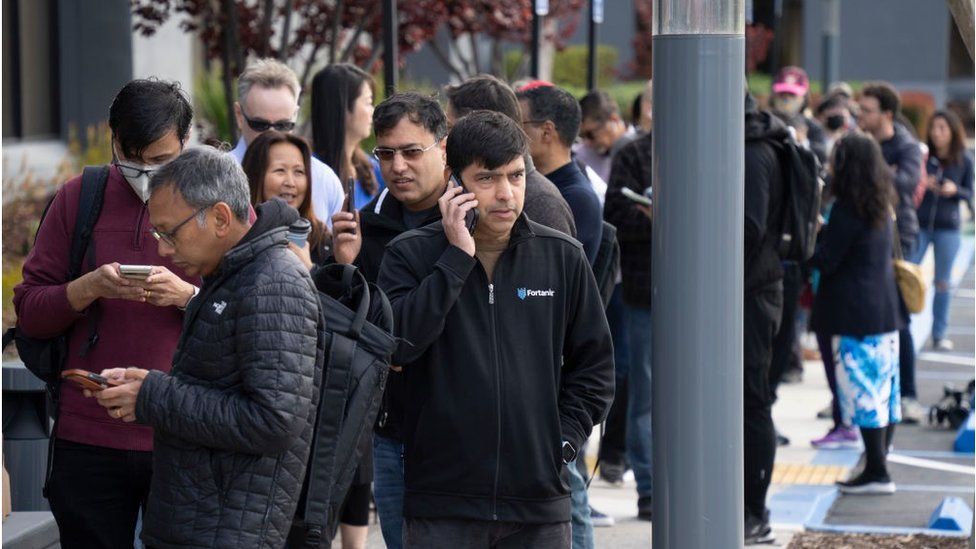

In the original Mary Poppins film, the nine year old Michael Banks accidentally starts a bank run by demanding back his tuppence coin.
The dynamics had barely evolved when in 2007, Northern Rock saw runs outside its branches, heralding the start of the 2007-08 global financial crisis.
A year on, when Bradford & Bingley ran into trouble, the Bank of England had spotters outside the bank’s branches but were relieved to see no such queues for the nation’s TV cameras.
 But the dynamics of bank runs appear to be evolving – and heading off such panics may be getting harder.
But the dynamics of bank runs appear to be evolving – and heading off such panics may be getting harder.
I have often pondered the following question: what would the 2007-08 financial crisis have been like in the current era of Twitter, Facebook, Instagram and TikTok?
That question may now be being inadvertently and not wholly positively answered by the current banking jitters.
Silicon Valley Bank saw the fastest bank run in US history according to the head of the US central bank, Jerome Powell. His vice chair Michael Barr told the US Senate yesterday that “social media saw a surge in talk about a run, and uninsured depositors acted quickly to flee”, pulling their funds “at an extraordinary rate of $40bn (£32bn)in one day”.
On the following day SVB anticipated “even greater outflows” and so “panic prevailed among SVB’s remaining depositors”.
These are utterly staggering sums. The contagion was cross-continental. The Bank of England told MPs on Monday that SVB UK, its British arm, had lost £3bn, or 30%, of its deposit base on the same day.
Governor Andrew Bailey earlier this week said: “One of the lessons that we have to take from Silicon Valley Bank, and it’s not the only example, is in an age of social media, the speed at which runs can take place. And in an age of digital banking, the speed at which social media can be translated into loss. This is very different from the Northern Rock-style queue at the branch”.
He pointed to looking at changing the regulations on bank safety to see if they “match to that sort of dynamic that’s taking place”.
The dynamic is a combination of instant internet banking and social media, meaning that a system built on credibility, faith, and trust are now inherently more fragile. Think about the leading lights in tech on WhatsApp groups or Slack, advising the companies they are invested in to withdraw all their cash.
“Bank run” doesn’t quite capture it. SVB was more of an 100 metre world record Olympic bank sprint.
And while SVB had its own special dynamic, with depositors concentrated in one industry, and with most deposits not covered by normal saver protections, these concerns do apply more widely.
A search of “bank run” on key social media over the past two weeks revealed a wide range of figures advising people to withdraw their cash from similar institutions.
Some of this was wrapped up into distrust of mainstream “experts” versus trust in cryptocurrency. Part of the success of Bitcoin, and crypto in general, has been evangelical scepticism of normal banking. This is now a vocal and noticeable online community, which was not present during the 2008 financial crisis.

All of this has not been helped by communications difficulties over what is and is not covered by US deposit guarantees.
The bottom line is that it is reasonable to conclude that a low trust environment bred on social media has a material impact on the fragility of a system built on faith.
That in turn might require a regulatory response.
The head of the Bank of England’s regulator, the Prudential Regulation Authority’s Sam Woods, told MPs yesterday that it might have to change its assumption about how quickly deposits can flee a bank.
At the moment what is known as the Liquidity Coverage Ratio assumes that a bank might only lose 0-20% of its retail deposits or 20-40% of its corporate deposits over a period of one month.
A reminder: SVB UK lost 30% of its deposits in a single day.
The current regulation seems likely to be changed, but the flip side of that will mean that banks might not be able to lend as much into the economy.
Perhaps this is an overreaction to the very special case of SVB. It is a careful balancing act. Other jurisdictions are also pondering whether to increase the amount of deposits covered under protection schemes. It is a fair criticism, however, that it is unrealistic to imagine businesses can bank, and run payrolls, from dozens of bank accounts, designed to protect all their deposit balances.
The good news is that the UK regulatory system has performed well so far. SVB UK was obliged to turn into a subsidiary last year, and that meant it had the assets to be sold on intact to HSBC, without taxpayer funding.
But the way we calculate the safety of banks may change quickly as a result of this month’s “Insta-run”. – bbc.com